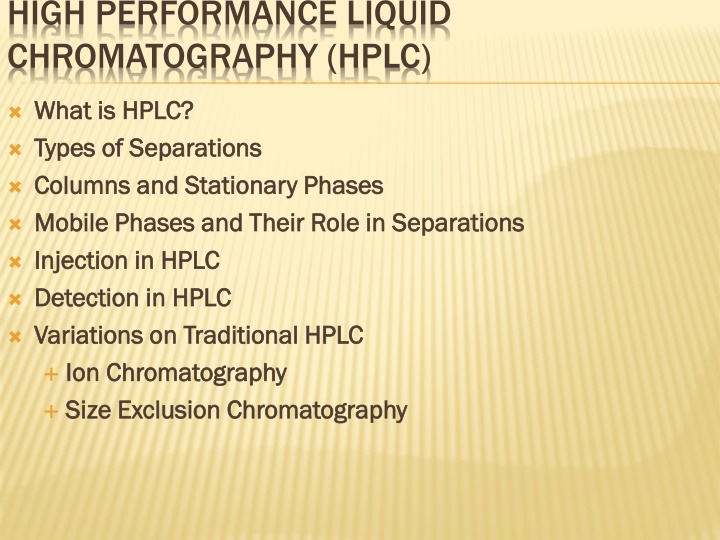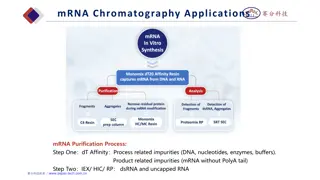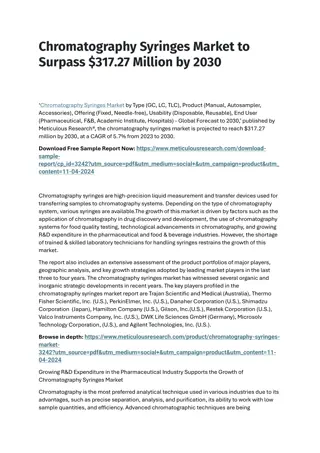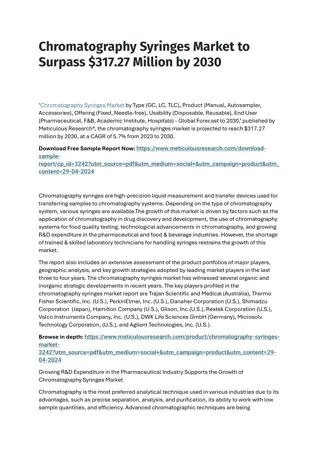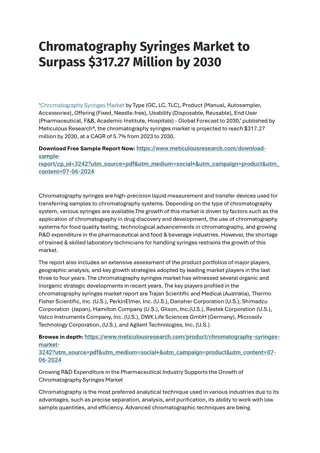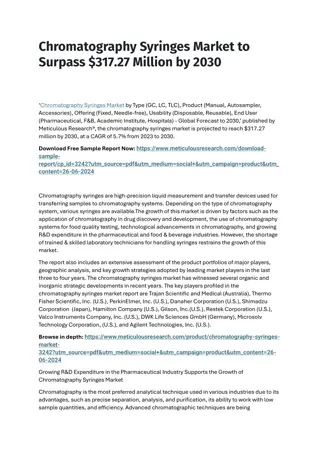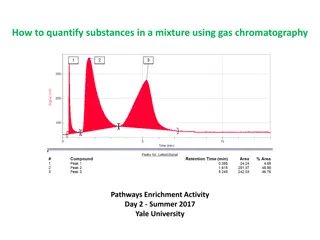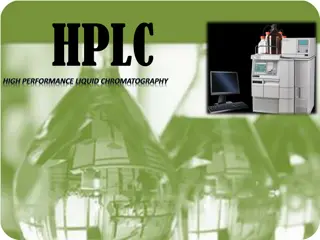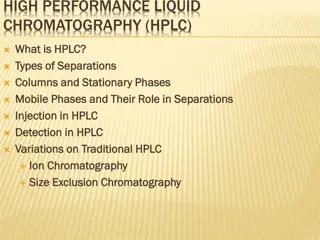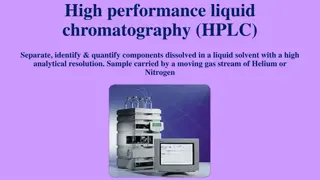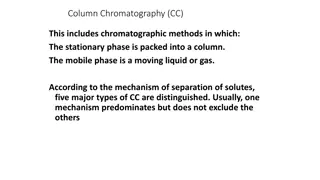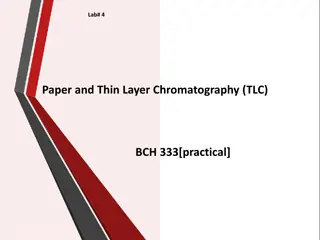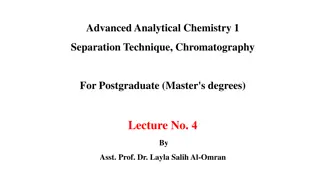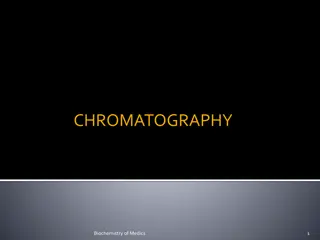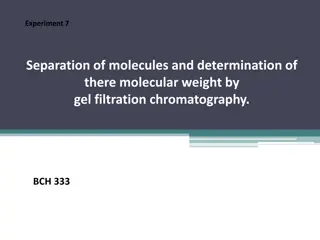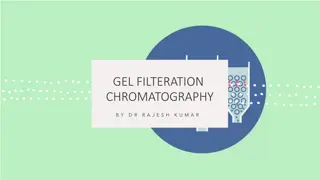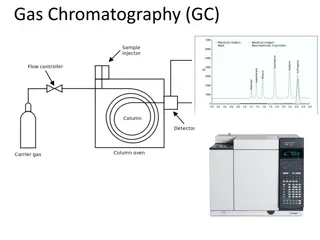HIGH PERFORMANCE LIQUID CHROMATOGRAPHY (HPLC)
High-Performance Liquid Chromatography (HPLC) is a powerful analytical technique used for separating and quantifying components in a mixture. It involves various types of separations, columns, stationary phases, mobile phases, injection methods, detection techniques, and variations. HPLC detectors play a crucial role in analyzing analytes efficiently, with different types available for specific applications. Analyzing analgesics using HPLC with UV detection showcases the importance of detector settings in determining peak areas accurately. A good detector for HPLC should exhibit low drift, noise levels, high sensitivity, fast response, and a wide linear dynamic range.
Download Presentation

Please find below an Image/Link to download the presentation.
The content on the website is provided AS IS for your information and personal use only. It may not be sold, licensed, or shared on other websites without obtaining consent from the author.If you encounter any issues during the download, it is possible that the publisher has removed the file from their server.
You are allowed to download the files provided on this website for personal or commercial use, subject to the condition that they are used lawfully. All files are the property of their respective owners.
The content on the website is provided AS IS for your information and personal use only. It may not be sold, licensed, or shared on other websites without obtaining consent from the author.
E N D
Presentation Transcript
HIGH PERFORMANCE LIQUID CHROMATOGRAPHY (HPLC) What is HPLC? What is HPLC? Types of Separations Types of Separations Columns and Stationary Phases Columns and Stationary Phases Mobile Phases and Their Role in Separations Mobile Phases and Their Role in Separations Injection in HPLC Injection in HPLC Detection in HPLC Detection in HPLC Variations on Traditional HPLC Variations on Traditional HPLC Ion Chromatography Ion Chromatography Size Exclusion Chromatography Size Exclusion Chromatography
DETECTORS Numerous Types Original HPLC Detectors were common laboratory instruments such as Original HPLC Detectors were common laboratory instruments such as spectrophotometers, etc. spectrophotometers, etc. Must be solvent Must be solvent - -compatible, stable, etc. compatible, stable, etc. Universal Universal respond to all analytes respond to all analytes Analyte Specific Analyte Specific respond to specific properties of analytes respond to specific properties of analytes Non Non- -destructive destructive most most Destructive Destructive ELSD, MS and a few others. ELSD, MS and a few others. Numerous Types
HPLC OF ANALGESICS - UV Detection Standard Analgesics Gradient = 0 min: 100% EtOAC (+ 0.2% HOAc) 3 min: 100% EtOAC (+ 0.2% HOAc) 5 min: 15% MeOH, 85% % EtOAc (+ 0.2% HOAc) 8 min: 15% MeOH, 85% % EtOAc (+ 0.2% HOAc) 10 min: 100% EtOAC (+ 0.2% HOAc) SiO2 Flow Rate = 1 mL/min UV detector set at 240 nm 2.82 min Acetaminophen 1.48 min. Aspirin Analgesic Retention Time 2.82 1.48 7.11 min. Caffeine Acetaminophen Aspirin 1.35 min. Ibuprofen Caffeine 7.11 Ibuprofen 1.35
HPLC OF ANALGESICS - UV Detection Area % Excedrin ES 250 mg aspirin 250 mg acetaminophen 65 mg caffeine Aspirin 19.5% Acetaminophen 50.0% Caffeine 20.5% Question The peak areas of aspirin and acetaminophen are very different, even though they are present in equal amounts (250mg/tablet) in Excedrin ES. Caffeine is present at ~ the concentration of aspirin (65 mg/tablet vs. 250 mg/tablet), but it s peak area is greater than the peak area of aspirin. WHY? UV Absorbance of analgesics vs UV setting of detector
HPLC: Peak Area vs Detector setting UV Max Aspirin 225, 296 nm Acetaminophen 248 nm Caffeine 272 nm Detector set at 240 nm Area % Aspirin 19.5% Acetaminophen 50.0% Caffeine 20.5% Detector set at 254 nm Area % Aspirin 7.3% Acetaminophen 81.9% Caffeine 10.8% Detector set at 280 nm Area % Aspirin 24.8% Acetaminophen 39.3% Caffeine 35.9%
GOOD DETECTORS Regardless of the principle of operation, an ideal LC detector should have the following properties: Low drift and noise level (particularly crucial in trace analysis). High sensitivity. Fast response. Wide linear dynamic range (this simplifies quantitation). Low dead volume (minimal peak broadening). Cell design which eliminates remixing of the separated bands. Insensitivity to changes in type of solvent, flow rate, and temperature. Operational simplicity and reliability. It should be tuneable so that detection can be optimized for different compounds. It should be non-destructive.
MOST COMMON HPLC DETECTORS: Refractive index UV/Vis Fixed wavelength (no longer used) Variable wavelength (we have one) Diode array (we have one) Fluorescence (Weilin Huang has one) less common, but important Conductivity (we used in IC) Mass-spectrometric (LC/MS) Evaporative light scattering
STANDARD ABSORBANCE DETECTOR. Single Beam UV Single Beam UV- -VIS instrument with a flow VIS instrument with a flow- -through cell (cuvette) Can use any UV Can use any UV- -VIS with a special flow cell VIS with a special flow cell Extra connections lead to band Extra connections lead to band- -broadening if UV column exit. column exit. Usually utilize typical UV Usually utilize typical UV- -VIS lamps and 254 nm default wavelenth VIS lamps and 254 nm default wavelenth Can be set to other wavelengths (most) Can be set to other wavelengths (most) Simple filter detectors no longer widely used Simple filter detectors no longer widely used adjustable wavelength units are cost adjustable wavelength units are cost- -effective Non Non- -destructive, not destructive, not- -universal universal not all compounds absorb light not all compounds absorb light can pass sample through several cells at several different wavelengths can pass sample through several cells at several different wavelengths Usually zeroed at the start of each run using an electronic software Usually zeroed at the start of each run using an electronic software command. You can have real command. You can have real- -time zeroing with a reference cell. time zeroing with a reference cell. through cell (cuvette) broadening if UV- -VIS is far from HPLC VIS is far from HPLC effective
DIODE-ARRAY DETECTORS As already mentioned, a special feature of some variable wavelength UV detectors is the ability to perform spectroscopic scanning and precise absorbance readings at a variety of wavelengths while the peak is passing though the flow cell. Diode array adds a new dimension of analytical capability to liquid chromatography because it permits qualitative information to be obtained beyond simple identification by retention time. There are two major advantages of diode array detection. In the first, it allows for the best wavelength(s) to be selected for actual analysis. This is particularly important when no information is available on molar absorptivities at different wavelengths. The second major advantage is related to the problem of peak purity. Often, the peak shape in itself does not reveal that it actually corresponds to two (or even more) components. In such a case, absorbance rationing at several wavelengths is particularly helpful in deciding whether the peak represents a single compound or, is in fact, a composite peak. In absorbance rationing, the absorbance is measured at two or more wavelengths and ratios are calculated for two selected wavelengths. Simultaneous measurement at several wavelengths allows one to calculate the absorbance ratio. Evaluation can be carried out in two ways: In the first case, the ratios at chosen wavelength are continuously monitored during the analysis: if the compound under the peak is pure, the response will be a square wave function (rectangle),. If the response is not rectangle, the peak is not pure.
REFRACTIVE INDEX DETECTOR One of a very few Universal HPLC detectors. Non- -destructive Responds to analytes changing the RI of the mobile phase Responds to analytes changing the RI of the mobile phase requires a separate reference flow of mobile phase requires a separate reference flow of mobile phase Extremely temperature sensitive, usually heated Extremely temperature sensitive, usually heated sensitive to temp changes of +/ sensitive to temp changes of +/- - 0.001 No longer really widely used No longer really widely used Absorbance detectors are relatively cheap. Absorbance detectors are relatively cheap. Useful for process work, on Useful for process work, on- -line monitoring, etc. line monitoring, etc. One of a very few Universal HPLC detectors. Non destructive 0.001 C C
ELSD (EVAPORATIVE LIGHT SCATTERING DETECTOR) Universal, destructive Universal, destructive Useful for very large molecules, and a wide linear range Useful for very large molecules, and a wide linear range Analytes are de Analytes are de- -solvated in the detector solvated in the detector Molecules pass through what is essentially a large cuvette Molecules pass through what is essentially a large cuvette for a UV for a UV- -VIS instrument VIS instrument The reduction in light intensity detected (due to scattering The reduction in light intensity detected (due to scattering by the analytes) is measured by the analytes) is measured The larger and more concentrated a particular molecule is, The larger and more concentrated a particular molecule is, the greater the scattering. The scattered light is detected by the greater the scattering. The scattered light is detected by a silicone photodiode located at a 90 angle from the laser. a silicone photodiode located at a 90 angle from the laser. The photodiode produces a signal which is sent to the The photodiode produces a signal which is sent to the analog outputs for collection. A light trap is located 180 analog outputs for collection. A light trap is located 180 from the laser to collect any light not scattered by particles from the laser to collect any light not scattered by particles in the aerosol stream. in the aerosol stream.
